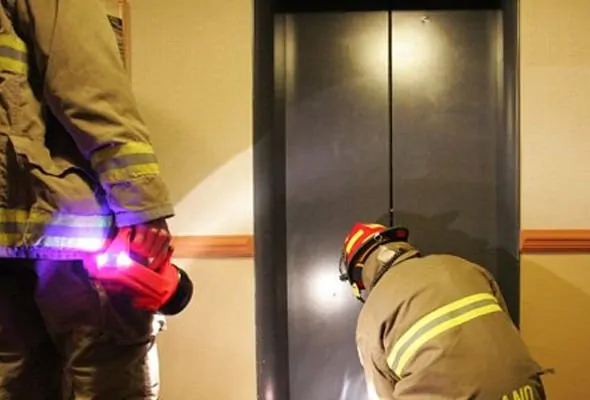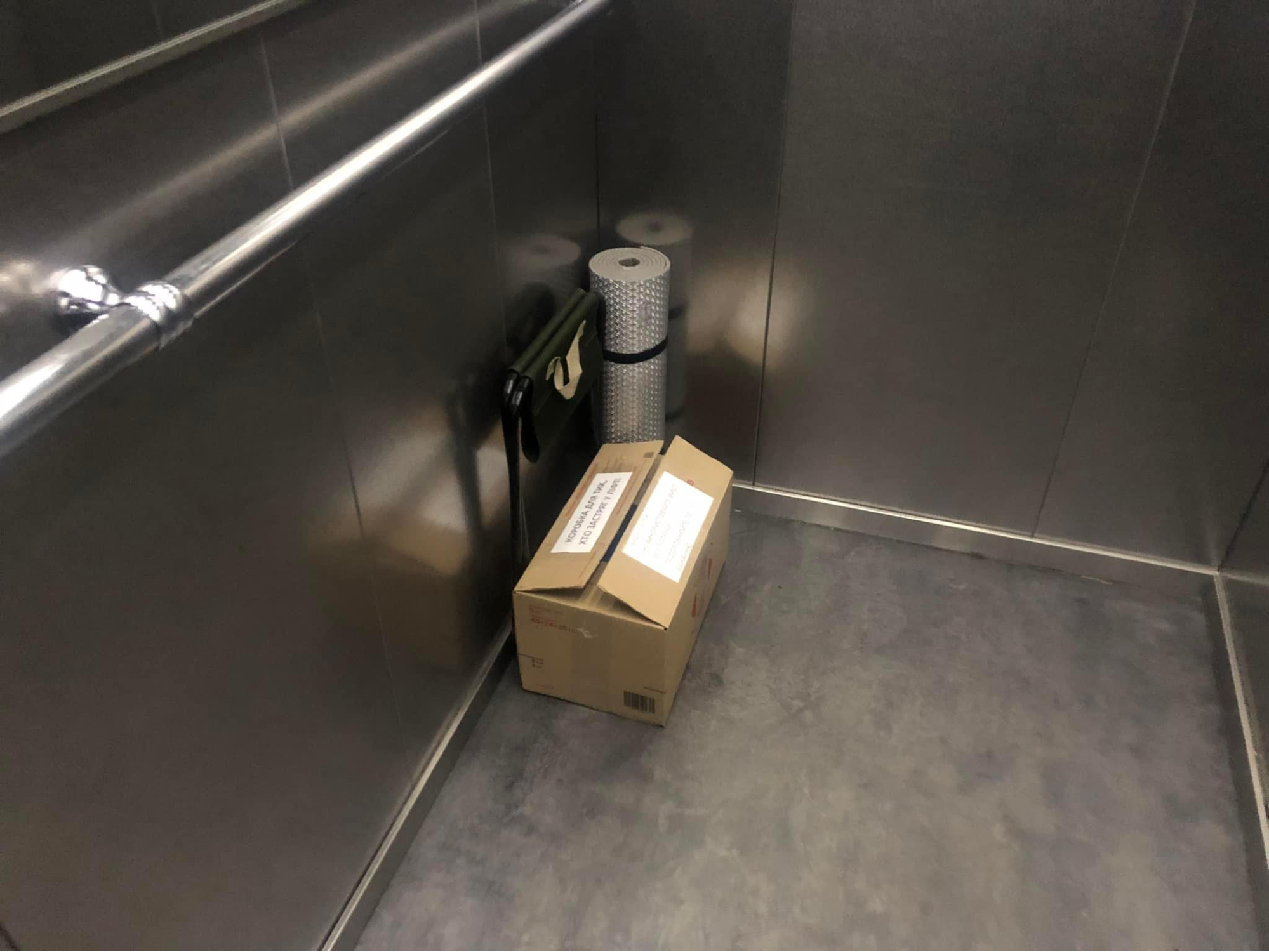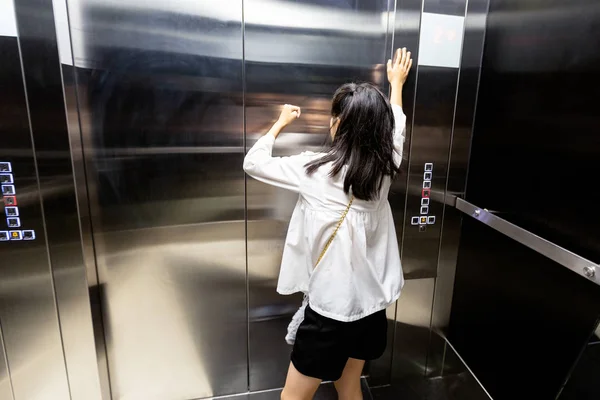
What is the problem?
We have been feeling the consequences of massive russia's attacks on Ukraine's energy infrastructure for more than a month. And if you can somehow adapt to scheduled shutdowns, then emergency shutdowns always come as a surprise. In such conditions, at any moment, high-rise buildings residents risk being stuck in an elevator for a long time.
What are the solutions?
Utility company workers advise that when a power outage can happen unexpectedly, only use the elevator with an urgent need. And the residents of the high-rise buildings themselves joke: an elevator that does not work is an additional fitness. The higher the floor, the better. This statement, which is quite true for young and healthy people, sounds controversial for mothers with babies, the elderly, and people with health problems: it is not easy for them to climb the stairs to the upper floors, and sometimes it is impossible.
Self-organization helps Ukrainians today. An army of volunteers helps the Armed Forces at the front, and self-organization in the rear helps to survive blackouts after missile attacks by a terrorist country.

Residents leave bags or boxes in high-rise elevators in case the lights go out. They put flashlights, water, napkins, cookies, hygiene bags, and sometimes even medicine there. All this so that if a power outage finds someone in the elevator, it would be easier for the person to stay there until the light returns.
However, even with a "support package" in a small and dark confined space, a person can get confused or even panic. Rubryka talked to Yana Polishchuk, a child and family psychologist, art therapist, and founder of the "Sunny Space" psychological studio (Irpin), to find out how not to succumb to a sudden claustrophobia attack and how to help yourself and your loved ones if you are trapped for a few hours in an elevator.
How does it work?
"To begin with, it is worth distinguishing between the concepts of claustrophobia (fear of a limited closed space) and a panic attack as a reaction to one or another factor," says psychologist Yana Polishchuk. The psychologist insists that it is much more difficult to cope with a phobia and work with it requires long-term therapy because its manifestations are stronger and longer than anxiety and overwhelm during a stay in an elevator. But those disturbing manifestations in the mind and body, which arise as a reaction to a stressful event, can be taken under control.
Adjusting your breathing is the first rule of thumb for any stress response. After all, when it becomes superficial and frequent, a feeling of suffocation may appear. Therefore, it is very important to balance it. Any methods of concentrated and deep breathing that are comfortable for a person can be used here (breathing in a square, breathing "4-7-8", breathing into a bag, etc.). After performing several repetitions, the body will begin to respond adequately to the situation that has developed.
The second important point is the bodily reaction. Because this is an elevator, you should not perform jumping exercises here. It is better to take a sitting position to increase the area of bodily sensations maximally and periodically tense and relax the muscles and apply pressure to different parts of the body.
The next point is an emotional response. The priority here is to realize what really happened: I am now in the elevator, I am scared, and what can I do about it now? That is, we start to act.
Here you should not forget and, first of all, perform the algorithm of typical actions advised by rescuers.

- Do not try to open the cabin door yourself, and do not randomly press all the buttons.
- Use the dispatcher's call button or the emergency elevator service phone number to report the problem and your location.
- If the dispatcher or the emergency lift service does not respond or cannot come, call 101.
- If there is no phone or mobile connection, call the house residents for help and ask them to call the emergency services.
- After the arrival of the emergency team, follow their instructions clearly.
Yana Polishchuk adds that the best way to avoid any stress, including in the elevator, is to have an action plan. Download emergency service contacts, an audiobook, or a movie to your phone in advance, and have a basic set of necessary things with you (power bank, water, snack, napkins, a notebook with a pen).
What to put in the "rescue box"?

"The fact that the humanity of Ukrainians knows no bounds is gratifying, and you can often find rescue boxes in elevator cabins. What should be put there first? There should be something that will relieve physical discomfort. It may be
- water,
- blanket,
- paper bag for breathing,
- strong garbage bags for physiological stools (or a diaper or a closed, empty container made of plastic),
- food: nuts, cookies, dried fruits, candies (sucking lollipops is soothing),
- wet and dry wipes,
- mild sedative,
- pencils and paper in case a child ends up in an elevator trap," the psychologist advises.
What psychological techniques-actions will help to cope with stress?
- Oddly enough, you can relieve emotional tension with the usual walking and counting method (when you walk and count your steps) — in this way, you will be able to process excess cortisol and adrenaline, which are released in stressful situations. If the elevator is small, the steps can be small. It releases stress through the body and slows it down.
- It is also a great way to close your eyes and meditatively imagine that you are now in a peaceful place, try to see it with your inner vision in all its details, hear the sounds of this place, and become familiar with it. Anxiety will recede.
- A very effective technique for dealing with stress is the "Butterfly Hug" technique: you need to cross your arms on your chest so that the right hand rests on the left shoulder and the left hand rests on the right. Then start slow alternate tapping with your fingers in the collarbone area. You should repeat the exercise about eight times.
How to help a child?
It is also worth teaching the child the principles of bodily self-help in case of panic: breathing, butterfly hugs, and counting. You can also add an important fantasy moment — imagine yourself as a superhero who, for example, has stopped time and is planning an important strategy to save the world or your apartment from excess garbage. You can create a new fairy tale together, turn into a "whyer," and ask the child questions, even about what happened to the elevator.
How a mirror can help?
A mirror, which is now in almost every elevator, will help to cope with panic. Interestingly, the elevators' mirrors did not appear to take a selfie or fix your hair before leaving the house. They help people suffering from the fear of limited space. Mirrors visually increase the space and reduce anxiety from the fact that you are in a small room. Elevators with mirrors also add a sense of security, as a person can observe what other passengers are doing without unnecessary movements.
In addition to the mirror creating the effect of spaciousness, it can become an additional moment of the bodily-emotional reaction of fear, in which you can see the reflection of your emotions. Also, with the help of a mirror, you can start long and even breathing.
With children, the mirror can be used as an element of the game: to frighten fear by making faces, or after exhaling, draw with your finger on the mirror, which will leave a trace of steam condensate.
"Any extremely complex emotional situation requires time and effort so that all hormonal processes approach the state of a calm norm. That's why it's always important to study your body, to understand what works with you to be able to tame the most stressful event," Yana Polishchuk sums up.
More useful solutions!

Even when there is electricity, an irrational fear of using an elevator is quite common.
Why are people afraid of elevators? Elevators appear in many horror films. These clips are well remembered and can be easily projected onto oneself by a person under stress. In addition, even if something dangerous happens to someone in an elevator in real life, this news is spread in the media for several days, and the recordings of video surveillance cameras can "wander" on the network for many years. Agree, even without a personal negative experience, this is enough to make a person afraid of elevators.
But, according to statistics, the elevator is actually one of the safest means of transportation. And the elevator cabin is the safest place in the event of a system failure.
If you happen to be stuck in an elevator, try to stay calm, follow the advice of rescuers and psychologists, and approach the situation with humor. This situation is temporary, and in a few days, you will remember it as an adventure with which you were able to cope.
This material was created by the online media outlet Rubryka within the framework of the "Ukrainian Rapid Response Fund" program, implemented by IREX, with the support of the US State Department. The content is the sole responsibility of the Rubryka online media outlet and does not necessarily reflect the views of IREX or the US State Department.








